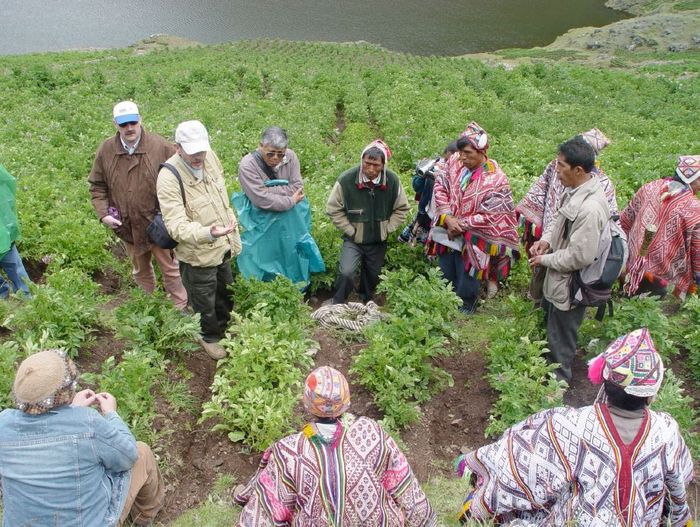The Potato Park brings together five Andean communities in the Cusco region of Peru. In the face of rural poverty in the Andes, it opens up new perspectives. Agro-ecotourism in the Park contributes to improving the socioeconomic situation. A communal fund ensures that the income from tourism is distributed equally. Other positive effects go beyond the monetary: better educational prospects, support for food sovereignty and a sense of ’good living’.
In 1998, a group of Andean communities – Amaru, Chawaytire, Pampallaqta, Paru Paru and Sacaca – established the Indigenous Biocultural Heritage Area (IBCHA), also known as the Potato Park (Parque de la Papa). It is located in the district of Pisaq, about 45 minutes from the city of Cusco, and covers an area of around 9.820 hectares. The communities are located at altitudes ranging from 3,200 to 5,000 metres.
The socioeconomic situation of the Cusco region is alarming. Data on poverty, malnutrition of children, or lack of education provide evidence. Communities at a higher altitude tend to be more vulnerable to climatic factors. Climate change worsens the situation, as it particularly affects the production of native potatoes, bringing with it unknown diseases and pests. As one villager of Paru Paru states, some 40 years ago native potatoes were harvested in abundance at an altitude of 3,700 metres. Today, in order to obtain the same produce, you have to cultivate at about 4,100 metres. This situation concerns the community of Sacaca (lowlands) less, where other crops such as corn are harvested to mitigate these climatic effects to some extent.
In the Potato Park, as in other Andean communities, a cash and a subsistence economy co-exist. “We cannot forget agriculture. We always live thanks to it. But we must always work besides. Agriculture is not enough, it is just for the food”, says a homestay provider of Paru Paru.
Agro-ecotourism in the Potato Park
The name ‘Potato Park’ refers to the biodiversity of the site, in particular its more than 1,000 varieties of ‘papas nativas’, as the native potatoes are called locally. The Park was born out of the initiative of the NGO ANDES (Asociación para la Naturaleza y el Desarrollo Sostenible). In cooperation with the International Potato Center, a research for development institution based in Lima, they repatriated native potatoes to the Park, thus initiating conservation work in the field.
In 2007, the agro-ecotourism project was officially created. ANDES plays a key role in logistical and organisational terms as well as in the training of the Park's tourism stakeholders. The Park is headed by the five community presidents who coordinate the Association of Communities of the Potato Park (ACPDP). It ensures the fair distribution of tourism profits to the five member communities through the communal fund. It is fed by the collection of entrance fees from tourists and other sources, e.g. donations, and to a lesser degree by contributions of ten percent of the tourism income by the tourism players working for the Park. They include ‘pututeros’ (musicians) and ‘varayoq’ (traditional political entities), local technicians and seven economic groups: local guides, ‘papa arariwas’ (technical experts in native potatoes), a group for medicinal plants, for crafts (weavers), for gastronomy, for homestay tourism, and for the botanical gardens.
The native potatoes are the iconic tourist object of the Park. ‘Papa arariwas’ (potato experts) show to the tourists the huge biodiversity of the potatoes and demonstrate the effects of climate change on the potatoes. The women of the gastronomy group cook diverse meals using native potatoes and other local produce. In the homestay experience, tourists can participate in the potatoes’ cultivation or harvest.
Food sovereignty
Agro-ecotourism not only values the native potato. It also encourages its local consumption. This has positive implications for food sovereignty. It is more than simple food security (which can be ensured through state programmes to distribute food to communities living in poverty): Communities control and decide what they eat.
In people’s daily lives, potatoes constitute a basic staple food throughout the year. They even make ‘chuño’ and ‘moraya’ (products resulting from the dehydration of potatoes) in order to have annual reserves. At the same time, agro-ecotourism, like other income generating activities, facilitates the purchase of other products that today are part of local consumption such as rice, noodles or sugar, diversifying diets.
Due to the irregularity of the flow of tourism and a rotational system for tourism stakeholders, agro-ecotourism leaves enough time to work on the land. Cash income from agro-ecotourism contributes to the purchase of animals that can be consumed a posteriori, such as guinea pig.
The idea of ’good living’
As agro-ecotourism is carried out in the Park itself, the villagers can easily combine this activity with farming, without the need to migrate to find employment. In spite of the fact that the profits are not necessarily a sufficient income, the Park’s tourism stakeholders consider this possibility a significant element and one associated with the idea of ’good living’. “As a porter, you feel cold and sleep on the ground. As a local guide you can stay in the community, keep your customs and stay with the family”, says a local guide from Paru Paru. Agro-ecotourism even contributes towards investing in the education of children.
It is this link between tourism and agriculture that makes the Park's agro-ecotourism successful and channels its beneficial effects to the socioeconomic and monetary sphere. Since the potato is the Park's main attraction and the locally consumed product par excellence, the biodiversity of native potatoes promotes both tourism and agricultural activity.
Cristian Terry graduated at the Institute of International and Development Studies (Geneva, Switzerland) and is currently doing his PhD in Social Sciences in the University of Lausanne (Switzerland). His research focus is on tourism dynamics in the Cusco Region, principally among the Andean indigenous population.
Translated from Spanish by Carla Davidson


